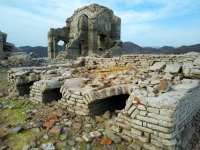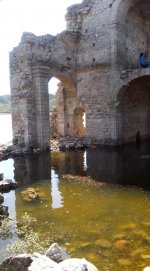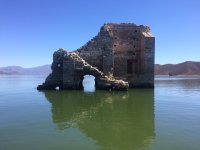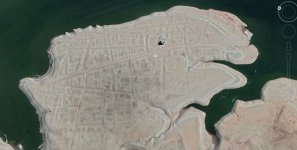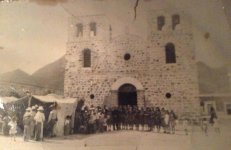Old Bookaroo
Silver Member
- Dec 4, 2008
- 4,474
- 3,795
In the summer of 2015 I posted a newspaper article by Henry O. Flipper. He wrote "You and your readers will undoubtedly recall the articles published in the Globe Democrat and other eastern papers, during the summer of 1887, on the discovery of certain 'lost mines' in the Sierra Madre by myself and other persons."
I've been looking for those articles ever since. In the meantime, I've posted other pieces about Flipper and his hunt for the Lost Tayopa in Old Mexico. Thanks to a tip from TN member "xaos," I just came across this article. It isn't, of course, the whole or final story. Just another piece of the puzzle.
Treasure Which Have Been
Hidden for More Than
a Century.
Special Dispatch to the [St. Louis] Globe-Democrat.
CITY of MEXICO, VIA EL PASO, Texas,
April 29. __ Any one at all familiar with Mexican history will recall the accounts of the seven lost mines, Humbolt [sic], Hamilton and, in fact, most of those who traveled in and wrote of Mexico, had something to say about these mines and the fabulous wealth obtained from them by the Spaniards. Humboldt made his tour through the country in 1804, and though the recollections of the treasures were comparatively fresh, there was no record or description from which the minds could be located. They were worked up to the middle of the last century.
In 1856 the Indians swept over Northern Mexico and destroyed Chihuahua. At that time the miners were either killed or driven off. Then it was that the seven mines, which were known as the richest in the world, were abandoned. The Indians held possession of the country so long that records were lost and the mountains of treasure were located only by tradition. One reason why more thorough search was not made was that so long as the Apaches were roaming through the mountains of Northern Mexico individual prospecting was out of the question as such could only be made with a small army. The Mexicans were always at the point of going to hunt the lost mines, but never got very far.
Tradition located these minds, or part of them, in Sonora, the northwestern of the Mexican states. The best information obtainable was that they were in the heart of a mountainous region not far from the Chihuahua boundary. Maximillian, toward the end of his attempt to establish an empire in Mexico, sent out an expedition in search of the lost mines. His plan was quite elaborate, and included the building of a railroad from the Pacific coast to the mines if he found them all right. Just at the time Maximillian was shot the expedition had located, as supposed, two of the lost mines, and the civil engineer, a Frenchman, had made a map of the region. The news reached the party that the empire was no more, the Mexicans scattered and the French engineer fled for his life. He sought refuge with a priest in the interior of Sonora, and after remaining in concealment some time, found means to reach the coast and thus escaped, but he left his map in the hands of the priest.
Now comes the recent developments, to which the foregoing is only preliminary. A three months’ expedition through Sonora has just been completed by a party of Americans, including Lieutenant Flipper, formerly of the United States army; W.K. Glenn, of Illinois; M.J. Power, of Sonora, and Captain Allen and J. McIntyre, of Chicago. Flipper and Glenn went out as civil engineers to report on the country in the interest of the Sonora Land company, of which J.A. Kruse, of Chicago, is the general manager. Power and McIntyre were in search of mines. The party has been out three months this time, but Lieutenant Flipper had previously spent a year surveying and looking up lands for the company in this same district.
Until this last expedition, it was necessary to keep the party together on account of the Indians. Mr. Kruse some months ago obtained through private sources, the map which Maximillan’s [sic] engineer had left behind him, and when Lieutenant Flipper and his associates started out about three months ago it was with the determination of trying to solve the mystery of the lost mines, or at least to make as good use as possible of the information from the French engineer had collected. In looking through the records of an old church in an interior village of Sonora, the Americans found corroborating evidence of the accuracy of the map.
ONE OF THE MINES DISCOVERED.
Thus encouraged they divided into four small parties and made a thorough search, having previously agreed upon a place of meeting. Flipper and McIntyre afterward came together with their men and located on what is believed to be the “Tayopa,” one of the list of seven. This is a silver mine. It is in the midst of thousands of buildings, among them large churches and forts. Within a radius of three miles Lieut. Flipper counted 420 workings, some of the shafts being several hundred feet deep. There were hundreds of old Spanish furnaces and tons upon tons of waste and slag. Capt. McIntyre discovered the mine, and men have already commenced where the Spanish let off in 1756. The ore from the mine is now being assayed.
Power and his party were gone so long that the others concluded the Indians or Mexicans had waylaid and killed them, but after six weeks, however, the men turned up with news enough to account for the delay. They had found the “Guaynopa,” another of the lost mines.
This is a free milling gold mine. It is in the heart of the Sierra Madre Mountains, and the workings are near the top of a conical shaped mountain. A road hewn through the solid rocks circles around this mountain, starting from the water at the base and leading to the mine. One chamber of the mine is 100 feet wide, 400 feet long and 90 [? — could be “80”] feet high. This will give an idea of how the mine was worked by the Spaniards. There are several of those chambers. There is no dump; every pound of rock has been taken out and carried down the mountain and worked, evidence that the ore was homogeneous and all rich enough to go to the Rastora [sic]. There are the ruins of 118 Rastoras at the foot of the mountain.
The Rastora was the old Spanish and Mexican stamp mill, consisting of rude mule power, by which large rocks were dragged over the ore, crushing it. Mr. Power has claimed this mine for Mr. Kruse and himself. The ore brought out has been assayed and gives $16 to the ton, it being perfectly free milling. By way of comparison it may be stated that the Homestake, probably the most profitable gold mine at this time in the States, pays $100,000 a month on ore which yields $8.80 a ton.
Mr. Power is the expert who located [?] the principal part of the Comstock lode in Nevada. He is a brother of Father Power of St. Louis. Also by this mine was found the deserted stronghold of the Apaches. There were forts on the mountain tops and tons of jerked meat were scattered about. The Apaches had utilized the homes from which the miners had been driven. There were indications of Indian occupancy extending through many years. The news of these discoveries had been brought to the City of Mexico by parties from Sonora.
The Aspen Daily Times [Aspen, Pitkin County, Colorado] 1 May 1887 [Volume III — No. 62]
------- o0o -------
For more on Henry O. Flipper, I refer the reader to my previous TN posts. I continue to search for a copy of his "Report," as documented in J. Frank Dobie's classic Apache Gold and Yaqui Silver. I have been in contact with several Texas libraries and archives, but those efforts haven't panned out yet. I did receive a copy of a short (two page) letter by C.B. Ruggles, describing another lost mine. Ruggles, of course, was Prof. Dobie's source for his information about the Flipper Report.
The hunt continues - for Flipper's Report, and for more articles from the summer of 1887 about his search for the Lost Tayopa.
Good luck to all,
The Old Bookaroo
I've been looking for those articles ever since. In the meantime, I've posted other pieces about Flipper and his hunt for the Lost Tayopa in Old Mexico. Thanks to a tip from TN member "xaos," I just came across this article. It isn't, of course, the whole or final story. Just another piece of the puzzle.
MEXICAN BONANZA.
_______
Two of the Seven Lost Mines
Discovered by Americans.
_______
Two of the Seven Lost Mines
Discovered by Americans.
[*=center]Mountains of
[*=center]_________
Treasure Which Have Been
Hidden for More Than
a Century.
CITY of MEXICO, VIA EL PASO, Texas,
April 29. __ Any one at all familiar with Mexican history will recall the accounts of the seven lost mines, Humbolt [sic], Hamilton and, in fact, most of those who traveled in and wrote of Mexico, had something to say about these mines and the fabulous wealth obtained from them by the Spaniards. Humboldt made his tour through the country in 1804, and though the recollections of the treasures were comparatively fresh, there was no record or description from which the minds could be located. They were worked up to the middle of the last century.
In 1856 the Indians swept over Northern Mexico and destroyed Chihuahua. At that time the miners were either killed or driven off. Then it was that the seven mines, which were known as the richest in the world, were abandoned. The Indians held possession of the country so long that records were lost and the mountains of treasure were located only by tradition. One reason why more thorough search was not made was that so long as the Apaches were roaming through the mountains of Northern Mexico individual prospecting was out of the question as such could only be made with a small army. The Mexicans were always at the point of going to hunt the lost mines, but never got very far.
SEARCHING FOR THE TREASURE.
Tradition located these minds, or part of them, in Sonora, the northwestern of the Mexican states. The best information obtainable was that they were in the heart of a mountainous region not far from the Chihuahua boundary. Maximillian, toward the end of his attempt to establish an empire in Mexico, sent out an expedition in search of the lost mines. His plan was quite elaborate, and included the building of a railroad from the Pacific coast to the mines if he found them all right. Just at the time Maximillian was shot the expedition had located, as supposed, two of the lost mines, and the civil engineer, a Frenchman, had made a map of the region. The news reached the party that the empire was no more, the Mexicans scattered and the French engineer fled for his life. He sought refuge with a priest in the interior of Sonora, and after remaining in concealment some time, found means to reach the coast and thus escaped, but he left his map in the hands of the priest.
AMERICAN ENTERPRISE.
Now comes the recent developments, to which the foregoing is only preliminary. A three months’ expedition through Sonora has just been completed by a party of Americans, including Lieutenant Flipper, formerly of the United States army; W.K. Glenn, of Illinois; M.J. Power, of Sonora, and Captain Allen and J. McIntyre, of Chicago. Flipper and Glenn went out as civil engineers to report on the country in the interest of the Sonora Land company, of which J.A. Kruse, of Chicago, is the general manager. Power and McIntyre were in search of mines. The party has been out three months this time, but Lieutenant Flipper had previously spent a year surveying and looking up lands for the company in this same district.
Until this last expedition, it was necessary to keep the party together on account of the Indians. Mr. Kruse some months ago obtained through private sources, the map which Maximillan’s [sic] engineer had left behind him, and when Lieutenant Flipper and his associates started out about three months ago it was with the determination of trying to solve the mystery of the lost mines, or at least to make as good use as possible of the information from the French engineer had collected. In looking through the records of an old church in an interior village of Sonora, the Americans found corroborating evidence of the accuracy of the map.
ONE OF THE MINES DISCOVERED.
Power and his party were gone so long that the others concluded the Indians or Mexicans had waylaid and killed them, but after six weeks, however, the men turned up with news enough to account for the delay. They had found the “Guaynopa,” another of the lost mines.
DESCRIPTION OF THE MINE.
This is a free milling gold mine. It is in the heart of the Sierra Madre Mountains, and the workings are near the top of a conical shaped mountain. A road hewn through the solid rocks circles around this mountain, starting from the water at the base and leading to the mine. One chamber of the mine is 100 feet wide, 400 feet long and 90 [? — could be “80”] feet high. This will give an idea of how the mine was worked by the Spaniards. There are several of those chambers. There is no dump; every pound of rock has been taken out and carried down the mountain and worked, evidence that the ore was homogeneous and all rich enough to go to the Rastora [sic]. There are the ruins of 118 Rastoras at the foot of the mountain.
The Rastora was the old Spanish and Mexican stamp mill, consisting of rude mule power, by which large rocks were dragged over the ore, crushing it. Mr. Power has claimed this mine for Mr. Kruse and himself. The ore brought out has been assayed and gives $16 to the ton, it being perfectly free milling. By way of comparison it may be stated that the Homestake, probably the most profitable gold mine at this time in the States, pays $100,000 a month on ore which yields $8.80 a ton.
Mr. Power is the expert who located [?] the principal part of the Comstock lode in Nevada. He is a brother of Father Power of St. Louis. Also by this mine was found the deserted stronghold of the Apaches. There were forts on the mountain tops and tons of jerked meat were scattered about. The Apaches had utilized the homes from which the miners had been driven. There were indications of Indian occupancy extending through many years. The news of these discoveries had been brought to the City of Mexico by parties from Sonora.
The Aspen Daily Times [Aspen, Pitkin County, Colorado] 1 May 1887 [Volume III — No. 62]
------- o0o -------
For more on Henry O. Flipper, I refer the reader to my previous TN posts. I continue to search for a copy of his "Report," as documented in J. Frank Dobie's classic Apache Gold and Yaqui Silver. I have been in contact with several Texas libraries and archives, but those efforts haven't panned out yet. I did receive a copy of a short (two page) letter by C.B. Ruggles, describing another lost mine. Ruggles, of course, was Prof. Dobie's source for his information about the Flipper Report.
The hunt continues - for Flipper's Report, and for more articles from the summer of 1887 about his search for the Lost Tayopa.
Good luck to all,
The Old Bookaroo
Amazon Forum Fav 👍
Last edited:


